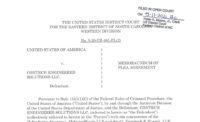Viewpoint: When Products Are Engineered To Deceive

An Audi engine similar to the kind that has engulfed Volkswagon in scandal. Photo by The Car Spy, via Wikimedia Commons.
 The requirements and details of the Clean Air Act defy logic and understanding at times, even to someone like me who deals with them every day. Anyone can make a mistake; however, purposefully engineering in order to obfuscate the facts is patently unethical. That’s why engineers of all kinds need to think hard about the way Volkswagen is alleged to have deceived consumers and government regulators about emissions from its diesel automobiles.
The requirements and details of the Clean Air Act defy logic and understanding at times, even to someone like me who deals with them every day. Anyone can make a mistake; however, purposefully engineering in order to obfuscate the facts is patently unethical. That’s why engineers of all kinds need to think hard about the way Volkswagen is alleged to have deceived consumers and government regulators about emissions from its diesel automobiles.
Although we may not be involved with automobiles or air quality, the details of what happened are a good example of the moral hazards faced by all engineers and especially the complex group dynamic that leads to trouble.
The Clean Air Act prohibits manufacturing a motor vehicle with a component meant to bypass, defeat or render inoperative a pollution-control device required for compliance with emissions limits. The “defeat device” is software in the electronic control module. According to the Environmental Protection Agency, when the software determines the vehicle has begun the emission test procedure, it directs the vehicle to employ a low nitrogen dioxide (NO2) temperature-conditioning mode; a status bit in the software indicates that a “temperature conditioning” mode is active.
The vehicle operates so that engine NO2 emissions are low and exhaust temperatures are high. At exactly one second after the completion of the test procedure, this software directs the vehicles to cease the low-NO2temperature-conditioning mode. In this “normal mode,” the emission control system is immediately less effective, yielding higher levels of NO2 from the engines and reduced exhaust temperatures.
Last September, the EPA found that many Volkswagen diesel-engine cars sold in the U.S. included this type of software, which can detect when a car is being tested and then modify its operation to provide results indicating compliance. Under normal, non-testing operation, the engines then would emit well above the advertised NO2 levels. Although this issue doesn’t involve safety, engineering ethics still apply. An engineer must create an honest work product.
I became an air-quality environmental engineer because I wanted to make a difference in protecting the environment. My job balances keeping the air clean with helping companies to make their product, whether it be electricity or widgets. That’s why such alleged blatant circumvention of the Clean Air Act angers me. This law is challenging enough. Forcing the EPA to regulate against deliberate violators complicates the rules for those who want to follow the law.
Effort Needed To Comply
Honest firms spend much time and money to maintain compliance, ranging from burning low-sulfur diesel to installing catalytic control devices on exhaust stacks. The EPA and state agencies operate a countrywide air-monitoring network that is focused on metropolitan areas with poor air quality, such as Houston, Washington, D.C., and Southern California. Inevitably, the monitors will detect the additional pollution emitted by Volkswagen’s not-so-clean diesel cars in the U.S. and will show that the pollution is contributing to the air-quality issues of these non-attainment areas.
The first corrupt step often begins with thinking that a requirement is too hard or unfair; an engineer then begins to slip down an unethical slope. Volkswagen’s crisis began in this manner. The company’s management initiated a new clean-diesel campaign, but the design engineers were stymied by the strict U.S. emissions standards. It’s easy to imagine the engineers thought the Clean Air Act limits were unreasonable or impossible to achieve. Given a tight timeline and budget, they decided to circumvent the EPA test. According to Chairman Hans Dieter Pötsch, the company operated under a tolerance for rule-breaking that extended to the entire company.
Engineering ethics encompass more than the myth of a lone engineer’s bad act. Today, ethical conundrums involve corporate reputations, governmental fines and systemic failures. Unlike solving an engineering design problem, ethics are more than inputting variables and calculating a solution. They require judgment and a stiff spine.
When an “unreasonable” or “unfair” challenge presents itself, pause and think before acting. Remember, engineering ethics require us to rise to the occasion and do the right thing.







